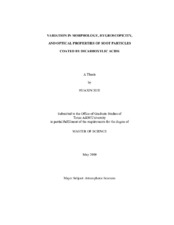| dc.contributor.advisor | Zhang, Renyi | |
| dc.creator | Xue, Huaxin | |
| dc.date.accessioned | 2010-07-15T00:11:17Z | |
| dc.date.accessioned | 2010-07-23T21:42:57Z | |
| dc.date.available | 2010-07-15T00:11:17Z | |
| dc.date.available | 2010-07-23T21:42:57Z | |
| dc.date.created | 2009-05 | |
| dc.date.issued | 2010-07-14 | |
| dc.date.submitted | May 2009 | |
| dc.identifier.uri | https://hdl.handle.net/1969.1/ETD-TAMU-2009-05-295 | |
| dc.description.abstract | Soot aerosols are well known to be atmospheric constituents, but the hydrophobic nature of fresh soot likely prohibits them from encouraging cloud development. Soot aged through contact with oxygenated organic compounds may become hydrophilic enough to promote water uptake. In this study, the tandem differential mobility analyzer (TDMA) and differential mobility analyzer?aerosol particle mass analyzer (DMA?APM) were employed to measure the changes in morphology and hygroscopicity of soot aerosol particles upon coating with succinic and glutaric acids. The effective densities, fractal dimensions and dynamic shape factors of fresh and coated soot aerosol particles have been determined. Significant size-dependent increases of soot particle mobility diameter, mass, and effective density (?eff) were observed upon coating of aggregates with succinic acid. These properties were restored back to their initial states once the acid was removed by heating, suggesting no restructuring of the soot core had occurred. Coating of soot with glutaric acid, on the other hand, leads to a strong size shrinking with a diameter growth factor ~0.60, even after the acid has been removed by heating suggesting the strong restructuring of the soot agglomerate. The additional 90% RH cycle can evidently enhance the restructuring process.
The extinction and scattering properties at 532 nm of soot particles internally mixed with dicarboxylic acids were investigated experimentally using a cavity ring-down spectrometer and an integrating nephelometer, respectively, and the absorption is derived as the difference between extinction and scattering. It was found that the organic coatings significantly affect the optical and microphysical properties of the soot aggregates. The size-dependent amplification factors of light scattering were as much as 3.8 and 1.7 with glutaric and succinic acids coatings, respectively. Additional measurements with soot particles that are first coated with glutaric acid and then heated to remove the coating show that both scattering and absorption are enhanced by irreversible restructuring of soot aggregates to more compact globules. These results reveal the microphysical state of soot aerosol with incomplete restructuring in the atmosphere, and advance the treatment of atmospheric aged soot aerosol in the Mie theory shell-and-core model. | en |
| dc.format.mimetype | application/pdf | |
| dc.language.iso | eng | |
| dc.subject | Soot, Morphology, Hygroscopicity, Optical Property, Dicarboxylic acid, Atmospheric aging. | en |
| dc.title | Variation in Morphology, Hygroscopicity, and Optical Properties of Soot Particles Coated by Dicarboxylic Acids | en |
| dc.type | Book | en |
| dc.type | Thesis | en |
| thesis.degree.department | Atmospheric Sciences | en |
| thesis.degree.discipline | Atmospheric Sciences | en |
| thesis.degree.grantor | Texas A&M University | en |
| thesis.degree.name | Master of Science | en |
| thesis.degree.level | Masters | en |
| dc.contributor.committeeMember | North, Simon | |
| dc.contributor.committeeMember | Collins, Don | |
| dc.type.genre | Electronic Thesis | en |
| dc.type.material | text | en |


